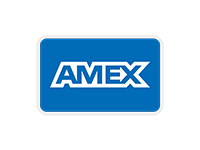By Craig Walker
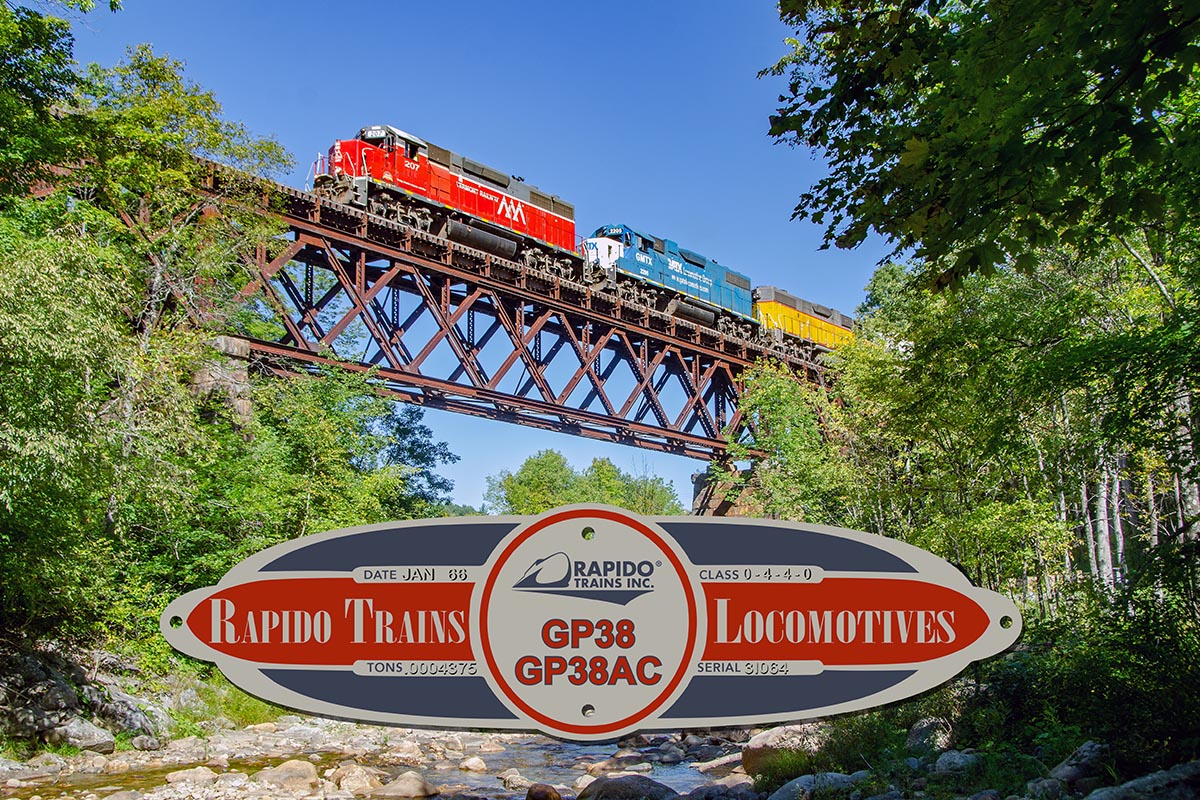
Vermont Rail System train lead by VRS GP38 207 (ex-DGNO 3800, ex-CBNS 3800, ex-CORP 3809, ex-LLPX 2002, ex-NS 2719, née-SOU GP38 2718) leads Rutland to Bellows Falls train GMRC 263-12 across the big bridge over the Mill River near Cuttingsville, Vermont, on September 12, 2016. Craig Walker photograph
The GP Evolution Continues
General Motors’ Electro-Motive Division (EMD) achieved success early on, having developed and marketed a variety of 4-axle road switchers beginning with the GP7. In early 1964 EMD had released the GP28, an 1800-horsepower non-turbocharged locomotive with a 567 diesel engine that looked more like the GP35 than the GP18 it replaced in their catalog. Unfortunately, GP28 sales were unimpressive, with only 26 built (16 in the US and 10 in Mexico).

The first GP38s built, in January and February 1966, were for the Detroit Toledo & Ironton (200-204). These engines featured dynamic brakes, nose headlights, an oscillating warning light on the cab and a bell mounted in the recess on the right side of the nose, as seen on DT&I 203 (the fourth GP38 built) in Sharonville OH on June 3, 1972. Dan Dover photograph, Greg J. Sommers collection
EMD unveiled the latest “Geep” – the 2000 horsepower GP38, a lower horsepower companion to the 3000 hp GP40, in late 1965, with the first order delivered in January 1966: Five GP38s for the Detroit, Toledo & Ironton (200-204).
The GP38 was a non-turbocharged locomotive, similar in appearance to the earlier GP35 and GP28 models. As with the GP28, the GP38 had two radiator fans and smaller paired exhaust stacks. The GP38, however, was 36” longer and featured a new style radiator grille and a straighter sill and redesigned fuel tank. As with other locomotives, GP38s could be ordered with, or without, dynamic brakes, as well as a variety of other options (a few had dual control stands, steam generators for passenger service, some railroads specified their own lighting options and short hood options).
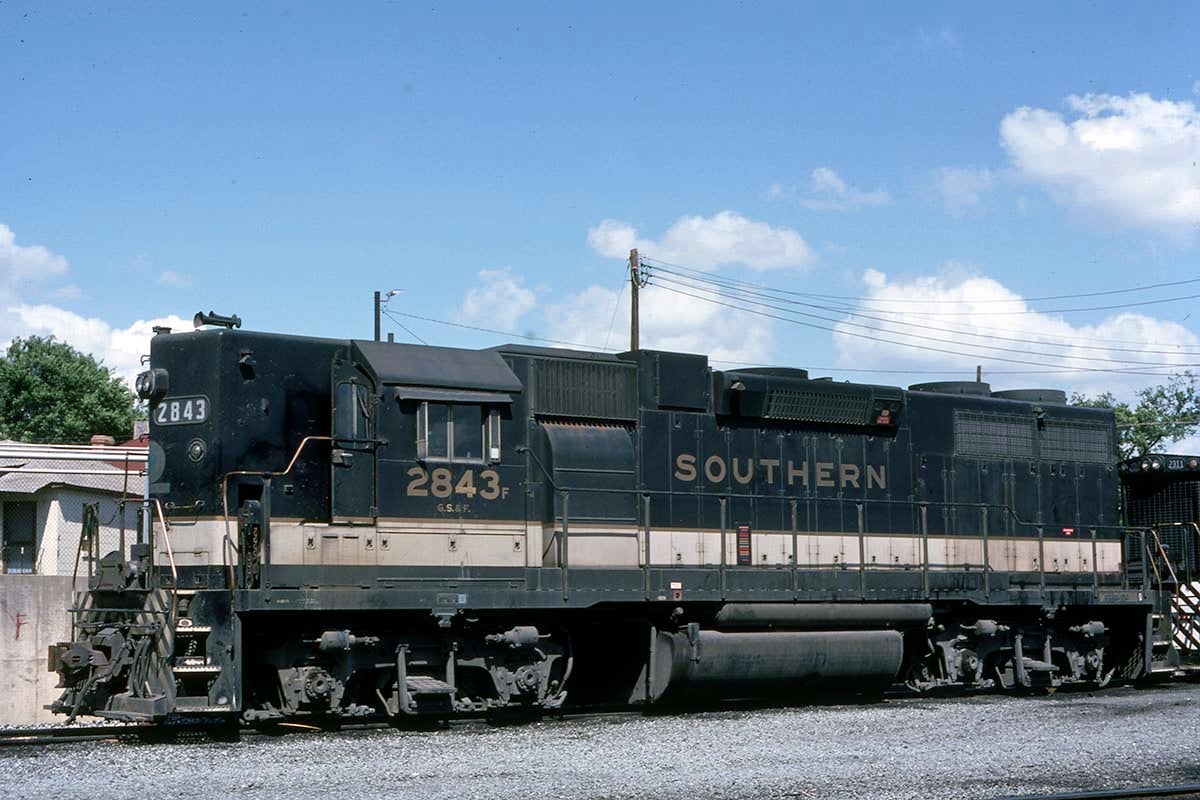
Southern Railway’s GP38s and GP38ACs, as with Norfolk & Western’s, were built with high short-hoods and operated long-hood forward (so the control stand was on the opposite side of the cab when compared to most GP38s). But in this photo of Southern GP38AC 2843, found in Atlanta GA on April 4, 1976, note the ribbed blower housing under the inertial grilles behind the cab. These ribbed housings are typically thought of as a spotting feature for EMD’s later Dash 2 line of diesels, but they actually began showing up on diesels constructed from mid-1971 and later – in this case, primarily on GP38ACs (including those built for DT&I, GM&O, L&N, LV, N&W, SLSF and SOU). Bill Folsom photograph, Greg J. Sommers collection
While initial sales for the GP38 were middling, after 18 or so months of production many railroads discovered the advantages of a locomotive that required less maintenance than the higher horsepower, turbocharged GP40. The GP38s slightly lighter weight also provided more versatility as well, suitable for lighter duty and for use on trackage that was often not for high-speed mainline trains, and even use in yards. It was purchased for a number of regional railroads, shortlines and a small number of industrial users. The GP38 was also popular with the larger railroads as well, as many needed to replace older lower horsepower locomotives. A total of 739 GP38s were built (712 for the US, 21 for Canada and 6 for México).
The GP38 was constructed with the 16-cylinder 16-645 prime mover and a D32 direct current (DC) generator, similar to all the other locomotives produced previously by EMD. The push for higher horsepower, however, necessitated larger DC generators and in 1970 EMD introduced a new option for the GP38 – an AR10 alternating current (AC) alternator in place of the generator. This was a solution to the space problems encountered by the large generator, as alternators were smaller, yet offered the same electrical capacity. Thus was born the GP38AC, which is externally identical to the GP38, which have DC generators. (Once again, the DT&I was the first to purchase this variation of the GP38 as well.) At least 240 GP38AC were built for America’s railroads.
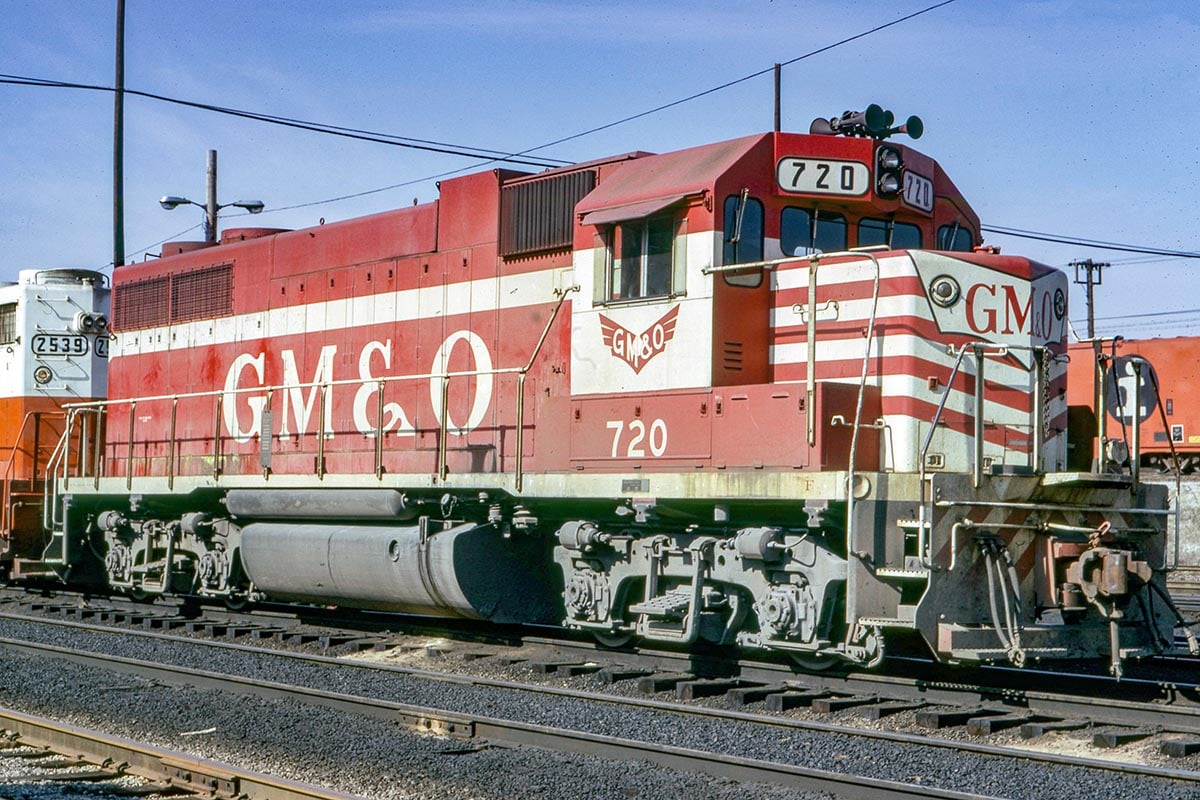
Gulf Mobile & Ohio GP38 720, photographed at East Hazelcrest IL on April 7, 1975, is about as “plain vanilla” as these engines came: No dynamic brakes, standard stepwells, no extra lights, no snowplow … but it did have a paper air filter and, a rarity for locomotives built in August 1969, it has poling pockets! Most railroads had ceased the practice of “polling” freight cars (shoving cars on one train by use of a pole by a locomotive on an adjacent track) by this time. Ray Kucaba photograph, Greg J. Sommers collection
Initial Owners
GP38s:
Aberdeen & Rockfish – 400 (1 locomotive)
Alto Hornos de México – 130-131, 135-136 (4 locomotives)
Atchison Topeka & Santa Fe – 3500-3560 (61 locomotives)
Baltimore & Ohio – 3800-3849, 4800-4819 (70 locomotives)
Bangor & Aroostook – 81-88 (8 locomotives)
Burlington Northern – 2072-2077 (6 locomotives, originally ordered by SP&S before the BN merger)
Canadian Pacific – 3000-3020 (21 locomotives, built by GMDD in London, Ontario, Canada)
Chesapeake & Ohio – 3850-3899, 4820-4829 (60 locomotives)
Clinchfield – 2000-2009 (10 locomotives)
Detroit Toledo & Ironton – 200-206 (7 locomotives)
Erie Mining Company – 700-701 (2 locomotives)
Ferrocarriles Unidos del Sureste – 512-513 (2 locomotives)
Gulf Mobile & Ohio – 701-720 (20 locomotives)
Louisville & Nashville – 4000-4019 (20 locomotives)
Maine Central – 251-263 (13 locomotives)
Missouri-Kansas-Texas – 300-304 (5 locomotives)
Missouri Pacific – 572-577 (6 locomotives)
Monongahela – 2000-2004 (5 locomotives)
Norfolk Southern (the shortline, not the Class 1) – 2001-2007 (7 locomotives)
Penn Central – 7675-7937 (263 locomotives)
Pennsylvania-Reading Seashore Lines – 2000-2014 (15 locomotives)
Phelps Dodge Corporation – 47-54 (8 locomotives)
Southern Railway – 2716-2822 (107 locomotives)
Tennessee Alabama & Georgia – 80 (1 locomotive)
Texas Mexican – 857-860 (4 locomotives)
GP38ACs:
Detroit Toledo & Ironton – 207-220 (14 locomotives)
Grand Trunk Western – 5800-5811 (12 locomotives)
Gulf Mobile & Ohio – 721-733 (13 locomotives)
Illinois Central – 9500-9519 (20 locomotives)
Lehigh Valley – 310-313 (4 locomotives)
Louisville & Nashville – 4020-4049 (30 locomotives)
Norfolk & Western – 4100-4159 (60 locomotives)
Pacific Power & Light – 11 (1 locomotive)
St. Louis-San Francisco (Frisco) – 633-662 (30 locomotives)
Southern Railway – 2823-2878 (56 locomotives)
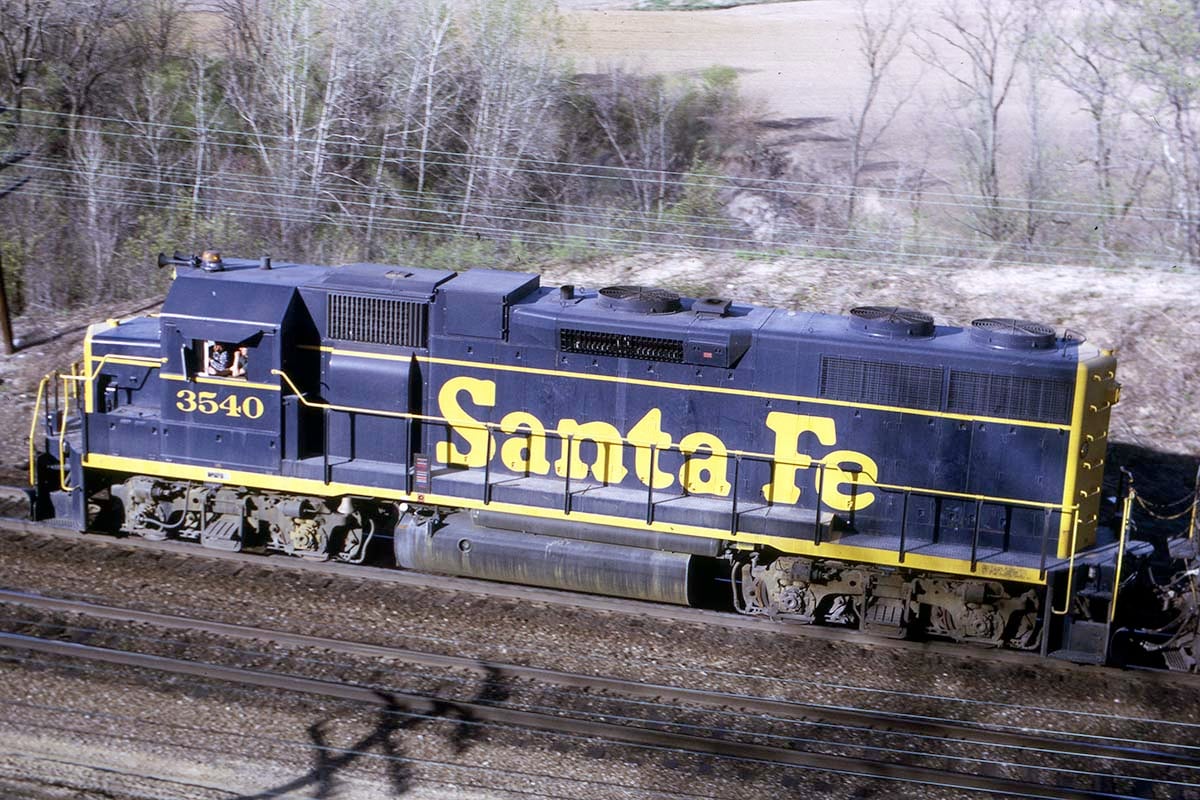
Santa Fe’s GP38s had two distinctive features: The “switcher stepwell” (corner stepwells in which all but the lowest step are set back, in order to allow a crewman to comfortably stand in the stepwell while switching cars without having his shins whacked by the other steps) and the unique dynamic brake vent with an exhaust stack in the center of it – Which we have only found on the Santa Fe’s GP38s. Look for another photo, a bit further down, showing a Santa Fe GP38 with the ”switcher stepwell” in use. (Chilocothe IL in May 1971.) Rich Panek photograph, Greg J. Sommers collection
Subsequent GP38 owners include those acquired through mergers (such as Burlington Northern, BNSF Railway, Canadian National, Conrail, CSX Transportation, Illinois Central Gulf, Norfolk Southern [this time the Class 1, not the shortline]) and Union Pacific, as well as sales to leasing companies (such as GMTX and LLPX) and other railroads and shortlines (such as Ann Arbor, Bangor & Aroostook, Central Oregon & Pacific, Central Vermont, Minnesota Northern and New England Central, among others).
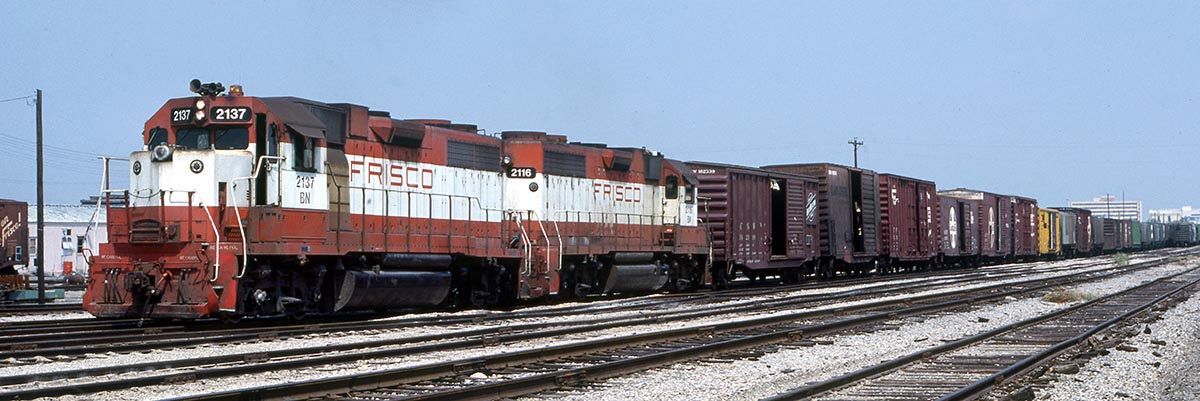
A pair of GP38ACs, built for the St. Louis-San Francisco (Frisco) but owned by the Burlington Northern when photographed in Fort Worth TX on September 6, 1981, show the GP38/GP38AC model in its element: Pulling a freight train. (Actually, these two were most likely building a train in the yard.) Frisco’s engines were built with a single Gyralight in their nose, which the BN retained for some time after the merger. These were eventually removed, leaving a notch in the nose. Robert Graham photograph, Greg J. Sommers collection
On The Job
Nearly six decades after the first GP38 emerged from EMD’s factory in suburban Chicago, paving the way for another thirty years of Geeps, GP38s are still plying rails all over North America, hauling tonnage on shortlines, regionals and Class 1 railways. The GP38 and its brethren were soon found on nearly all major, minor and railroads in-between within a few years of their debut. They were found on mainline manifests, branchline locals, transfers and yard jobs. GP38s worked trains by themselves, or were teamed with other GP38s, older GPs (GP7s, GP9s, GP30s, GP35s, etc.), six-axle diesels, newer Dash 2 locomotives, General Electric and ALCO diesels, older end cab switchers – GP38s were up for any task their railroads gave them! They were, indeed, dependable workhorses!
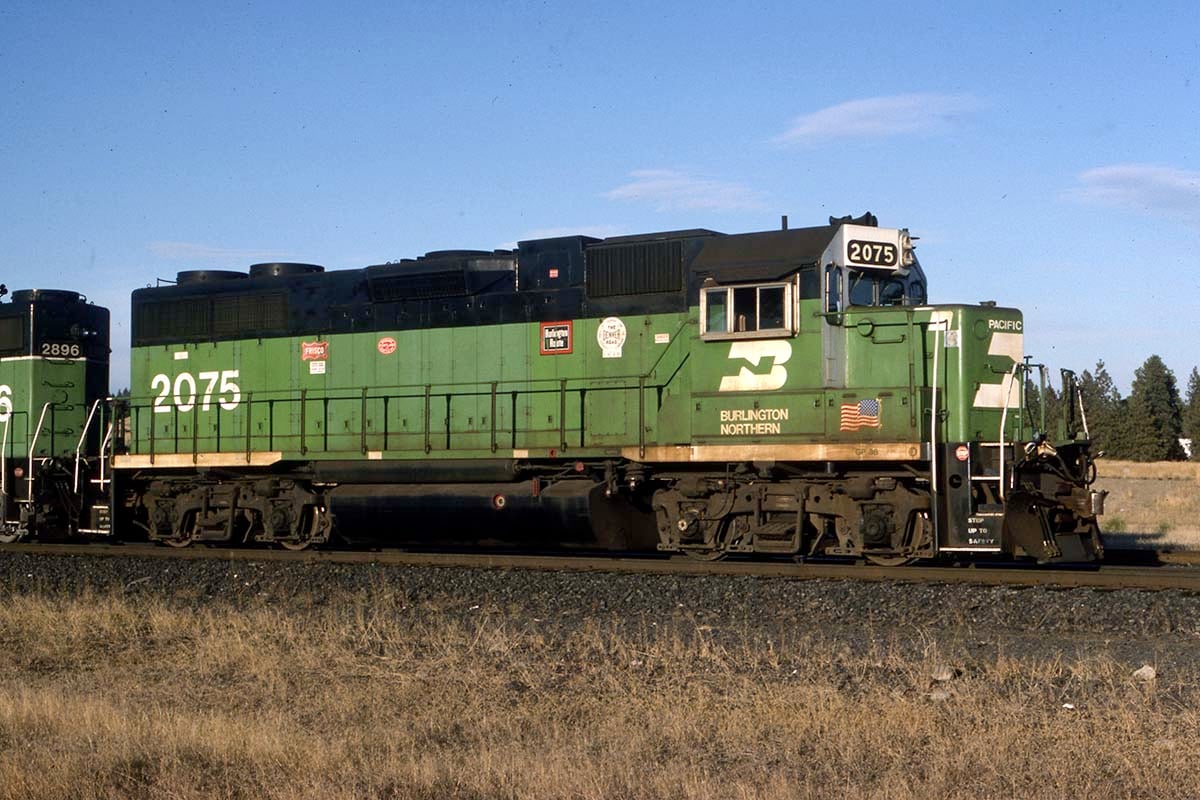
Here is a Burlington Northern GP38, painted in the special “Pacific Pride” paint scheme, featuring logos from the BN’s predecessor railroads. In this photo, the “switcher stepwell” mentioned in the caption for the Santa Fe engine can be seen more clearly. This engine was photographed on September 25, 1996. Ken Church photograph, Greg J. Sommers collection
Initially, many railroads opted for the higher horsepower turbocharged GP40, but when a nationwide swing toward more fuel-efficient locomotives and lower maintenance costs occurred, many of those roads ordered GP38s with their 2000 hp non-turbocharged V16 prime mover, sales experienced a surge. For example, after all but ignoring GP38s for GP40s, the Penn Central ended up ordering 240 of them 1969 to 1971. Many roads discovered upon adding GP38s to their fleets that they were ideal for nearly any assignment, from drag freights to branchline use.
As time passed, many GP38s were upgraded to GP38-2 specifications, and reclassed as such even though externally they are still GP38s in appearance, as they lack the Dash 2 spotting features. Others were modified externally quite a bit as well and no longer look exactly like either GP38s or even GP38-2s.
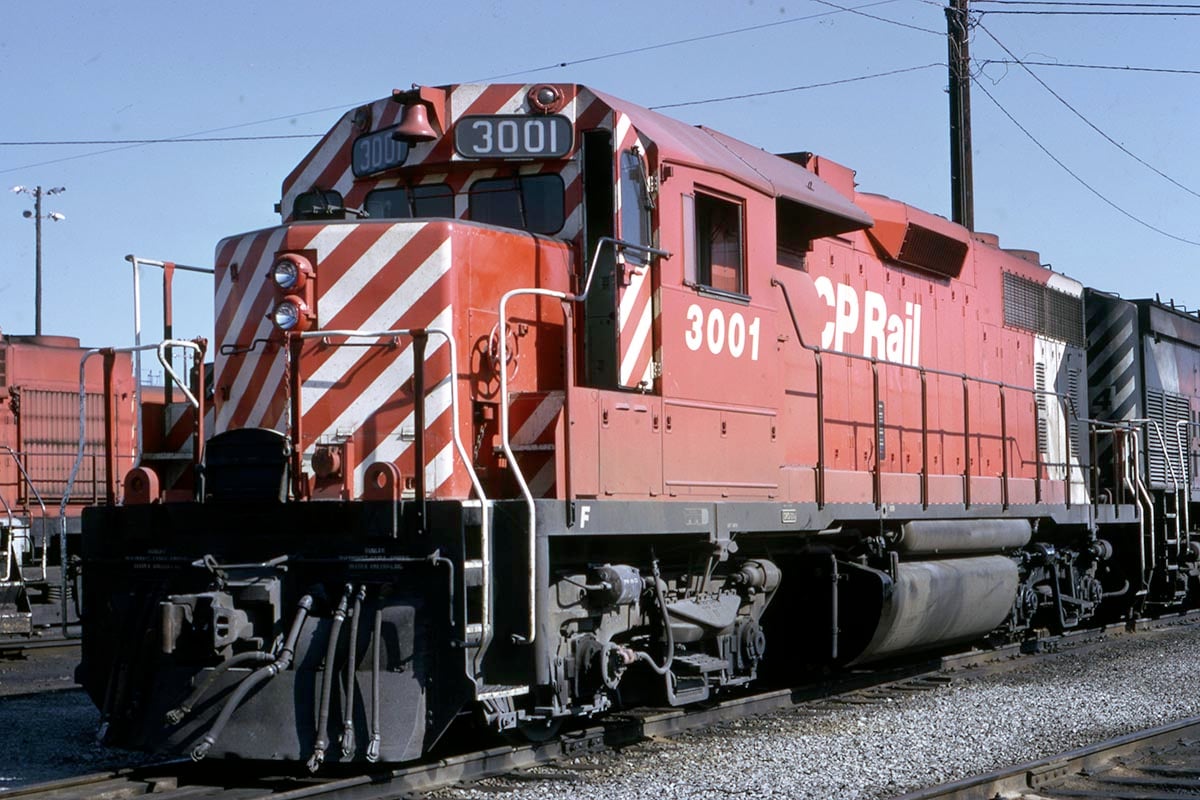
Canadian Pacific 3000-3020 were constructed by EMD’s Canadian subsidiary GMD in London, Ontario, and featured the Canadian-style stepwells, which were similar to, but different from, EMD’s “switcher stepwells”. CP 3001 was photographed in Agincourt, Ontario, on August 18, 1974. Greg J. Sommers collection
Variations … There Are Always Variations
As with so many locomotives, there were a number of variations, often due to their owners’ preferences, such as short hood (aka “nose”) heights, lighting options, etc.
Here is a list of many of these options and variations:
- A wide variety of air horns, snowplows, bell styles (and placement) were found on GP38s and GP38ACs. Checking photos is advisable.
- Perhaps the most obvious variation on GP38s and GP38ACs is the presence, or absence, of dynamic brakes and the resultant bulges on the long hood. A few GP38/GP38AC diesels had their dynamic brakes removed, with the d/b bulges’ grilles blanked over.
- The earliest GP38s were constructed with the early-style radiator fans (with a “pan” in the center), and at some point the newer fans, without the “pan”, were installed. This also applies to dynamic brake fans, should a locomotive be so equipped.
- There were three different stepwells used on GP38s:
- The standard version and the version often known as the “switcher” version, which has a more vertical step arrangement to allow a crewman to comfortably – and safely – stand on the bottom step when switching cars. Santa Fe and Burlington Northern GP38s featured this option.
- Canadian Pacific’s GP38s, having been constructed at GMD in Canada, were built with Canadian-style stepwells.
- Mostly delivered with oil bath air filters, many GP38/GP38ACs were retrofitted with paper air filters, easily distinguishable by the resultant box built into the roofline of the long-hood behind the cab. Often, this required a locomotive’s dynamic brake blister (if it were so equipped) to be modified as well.
- Fuel tanks were ordered in a variety of sizes, determined by the type of service in which a railroad’s locomotives would be assigned.
- Battery box covers varied somewhat in design, with variations of louvers, bolt patterns and, on B&O/C&O units, slots for enhanced cooling.
- While all GP38/GP38AC locomotives were delivered with class lights, as time progressed and they were no longer deemed necessary they were removed and replaced by gasketed blanks, plated over or neatly and smoothly filled in.
- The usual suspects, Norfolk & Western and Southern Railway, specified high short-hoods (commonly called “high-hoods”) on their GP38s and GP38ACs. Along with this option, they also had the control stands installed on the opposite side of the cab in order to operate their GPs long-hood forward.
- Two other railroads required dual control stands in their GP38s in order to operate them easily in either direction without having to turn them. This was, apparently, a control stand in the center of the cab, necessitating a built-out cab front to accommodate it. This also required an overhang on the cab front’s roof. These distinctive GP38s were delivered to Pennsylvania-Reading Seashore Lines (all 15 of their GP38s – 2000-2014, without dynamic brakes – although the last five were almost immediately relettered for PC, then assigned to the PRSL, with the other ten going to PC later) and Penn Central (10 units used to operate through the Detroit River tunnel, between Detroit MI and Windsor ON, and equipped with dynamic brakes, PC 7815-7824). All ended up as Conrail locomotives before being spread around North America to various leasers and shortlines.
- Detroit Toledo & Ironton GP38s 200-204, all of Gulf Mobile & Ohio’s GP38s and GP38ACs, and (the original) Norfolk Southern’s GP38s, were ordered with poling pockets, already an archaic feature by this time.
- Illinois Central ordered their GP38ACs with the optional L-shaped windshield, which provides a more unobstructed view for the engineer.
- As might be expected, there were a few lighting options on GP38/GP38ACs. Most were built with a twin sealed-beam headlight between the cab’s numberboards (or, in the case of the N&W and SOU locomotives with high short-hoods, between the numberboards on those short-hoods), but a few were delivered with other variations:
- Frisco’s GP38ACs were built with a single Pyle Gyralight in the nose.
- Illinois Central took delivery of GP38ACs with twin sealed-beam headlights mounted in their noses, and Oscitrol lights (two white lights with a red light underneath, all able to oscillate, with the red light used for emergency stops) mounted between the numberboards.
- Louisville & Nashville’s GP38ACs also had a twin sealed-beam headlight in the nose, and a conventional twin Gyralight mounted on the cab.
- Other locomotives, while not delivered with nose lights, had them added later, such as with late ATSF and BNSF locomotives, which had their twin sealed-beam headlights relocated from between the numberboards to their noses. And, naturally, ditchlights were added to these locomotives once they became a requirement.
- Detroit Toledo & Ironton’s GP38ACs were delivered with gong bells applied to their low short-hoods (aka “noses”).
- Some late production GP38s and, in particular, GP38ACs were constructed with ribbed blower housings, typically a spotting feature on GP38-2s but actually introduced in mid-1971, six months before the Dash 2 line was introduced.
- Santa Fe’s GP38 fleet utilized a unique combination dynamic brake vent/exhaust stack.
- In later years, some railroads (notably the Santa Fe) removed the outer brake shoes from the trucks under their GP38s.
- For a short time in the 1980s the Santa Fe added fins to the GP38s’ roofs in order to adjust the airflow to direct exhaust fumes higher. These didn’t last long.
- Disclaimer: Many of the parts were interchangeable, and as individual locomotives were serviced (or rebuilt following minor skirmishes with forces beyond normal wear and tear – that is, accidents) parts were often switched, resulting in a locomotive with mixed early and late fans, or battery box covers were changed, solid bearing trucks could end up with different styles of journal housings, et cetera. And, for additional fun, often the paint on these parts didn’t match, either. Of course, changes to rules or other requirements would result in changes, too, such as the removal of class lights in a variety of ways (as mentioned earlier … Don’t make me repeat myself!). This is all part of the fun of modeling a fleet of locomotives – the variations, often subtle and other times painfully obvious, over time give each locomotive a personality.
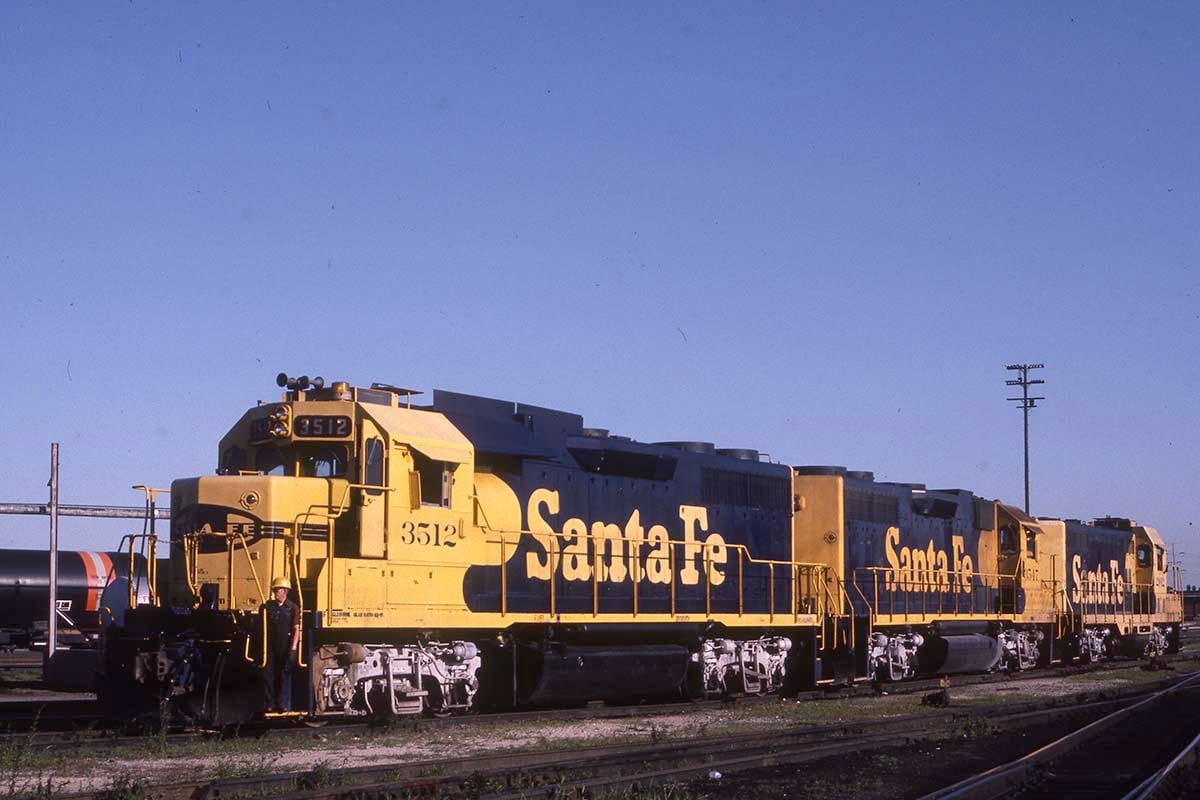
Santa Fe GP38 3512, photographed in Chicago IL on July 7, 1984, illustrates two details. First note the crewman riding in the stepwell variation (“switcher steps”) designed for this purpose, allowing him to remain upright safely and comfortably. Also, on the top of 3512 are the short-lived exhaust-lifter fins which, as the name more than implies, were designed to lift the engine’s exhaust higher and away from the crews. Greg J. Sommers photograph
Thanks to Ron Hawkins, Rick Morgan and Gregory J. Sommers for their assistance!
Gallery
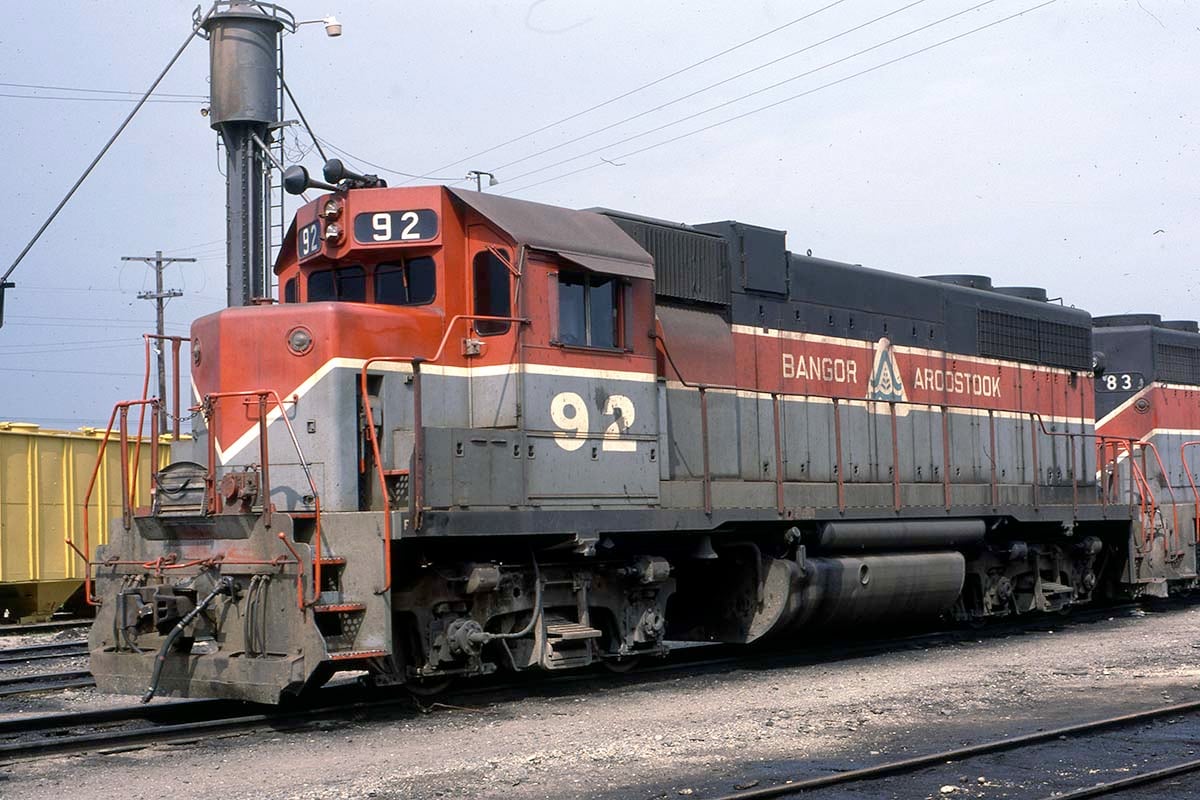
There were two railroads that purchased GP38s with dual cab controls for bi-directional operation: Pennsylvania-Reading Seashore Lines (for commuter operations) and Penn Central (for use in a tunnel being constructed). These engines needed a little additional space in the cab, and thus the front of the cab was extended by 12”. This is fairly noticeable, and the cab roof has a 12” extension as well. These all became part of Conrail’s roster, and then were sold off to other railroads and leasing companies. PRSL 2004 became Conrail 7664, and later Bangor & Aroostook 92. Note as well the location of the bell ato the short-hood. North Maine Junction ME, September 25, 1996. Jack Armstrong photograph, Greg J. Sommers collection
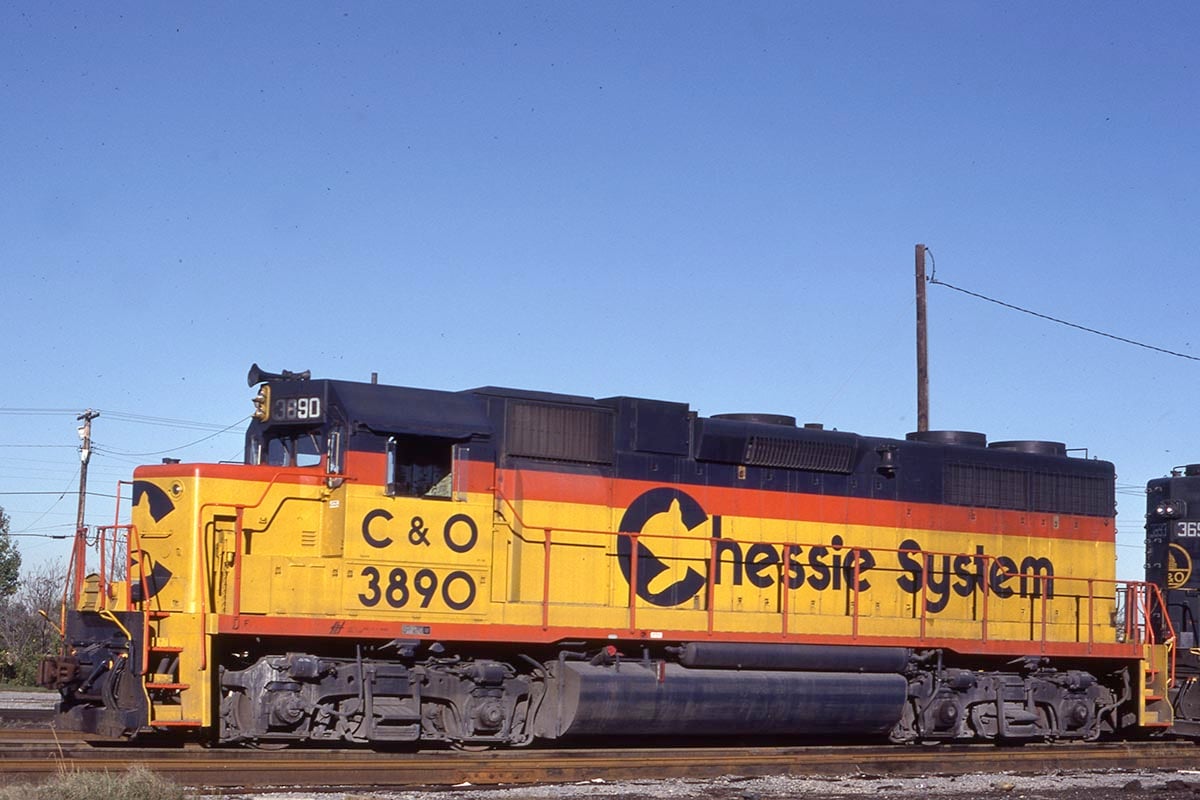
When paper air filters replaced the original oil-bath air filters, the change was noticeable because of the size of the air filter box on the engines’ roofline. And if the engine was equipped with dynamic brakes, as Chesapeake & Ohio’s were, then a modification needed to be made to the front section of the dynamic brake blister. This modification is clarly shown in this photo of C&O 3890 in Richmond VA on October 26, 1985. Doug Boyd photograph, Greg J. Sommers collection
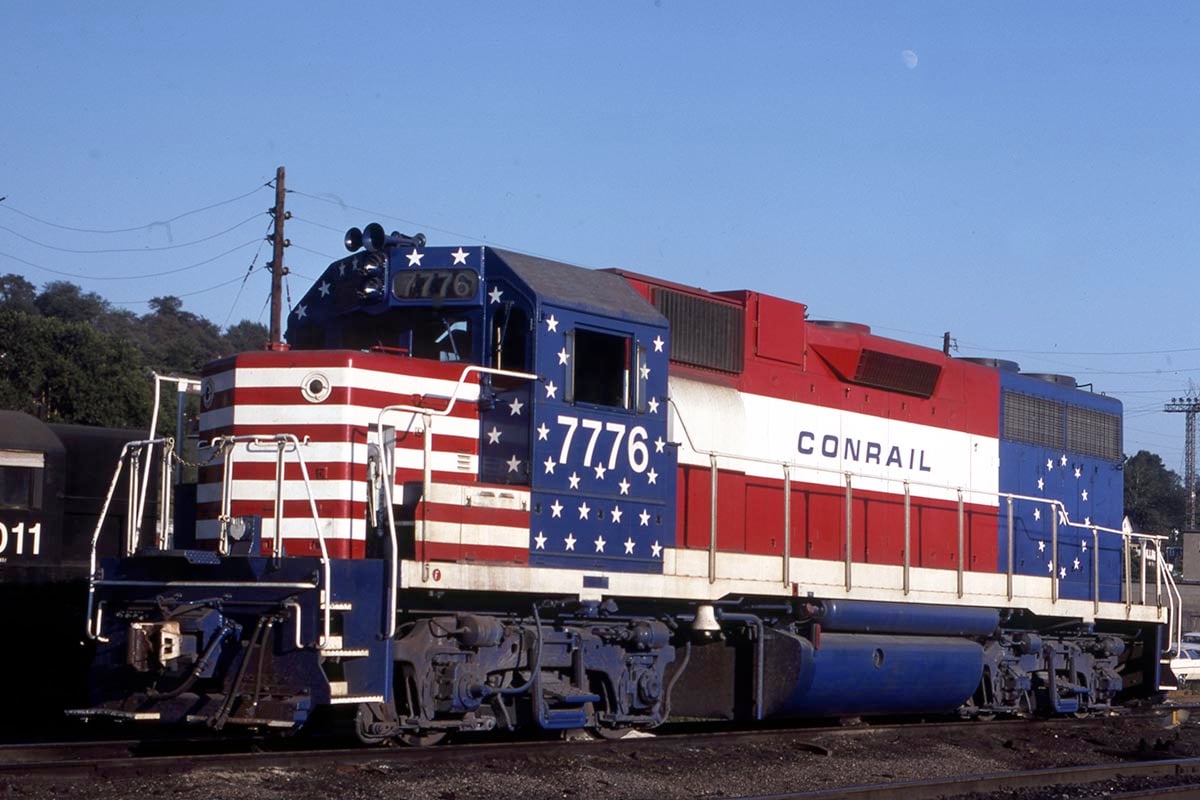
EMD’s GP38s and GP38ACs were hard at work around America in the mid-1970s, when fervor for the upcoming American Bicentennial was building. Most railroads chose at least one locomotive to paint in patriotic colors and markings to commemorate the country’s 100th Anniversary, and many of those were GP38s and GP38ACs. Here we see Conrail 7776 wearing its red, white and blue scheme in the appropriately named Freedom PA a few months after the big day, photographed on September 3, 1976. Other railroads with Bicentennial GP38s/GP38ACs include Grand Trunk Western, Illinois Central Gulf and Monongahela. Jim Claflin photograph, Greg J. Sommers collection
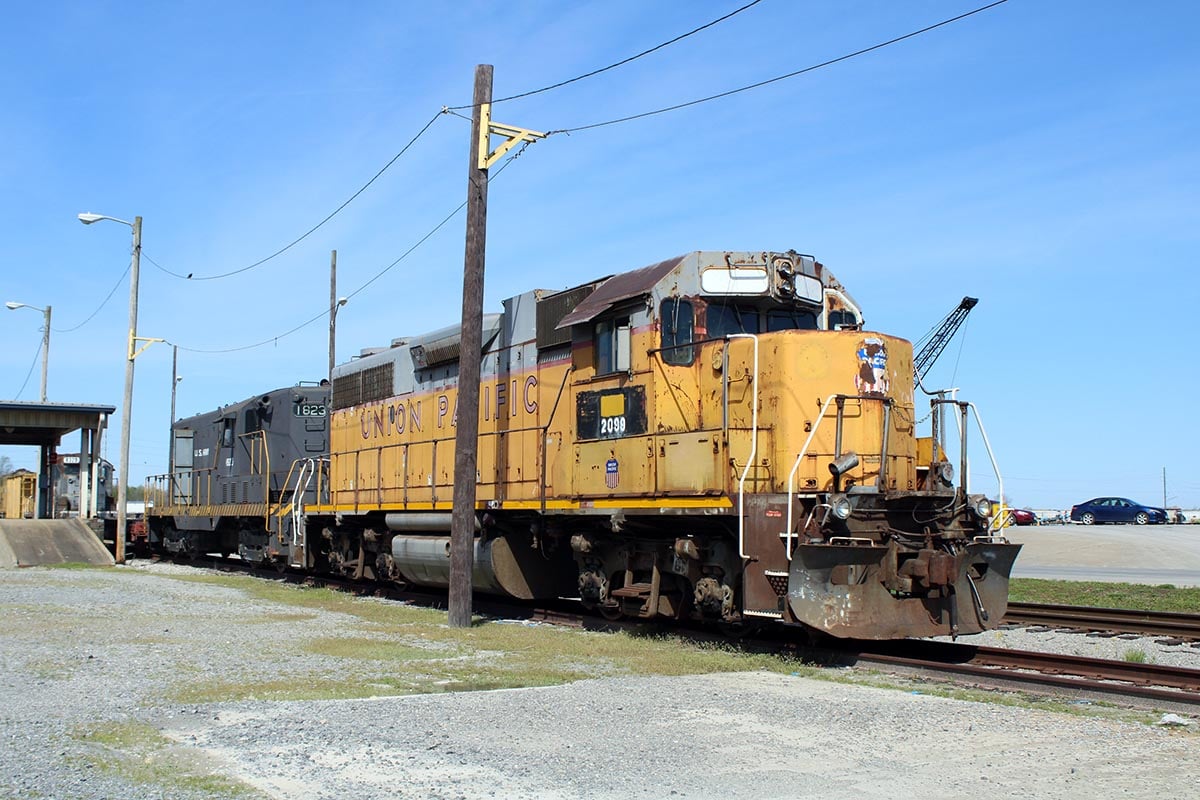
To illustrate how GP38s and GP38ACs often have complicated heritages, we present a photo of Midwest Locomotive Leasing and Sales (MWLX) GP38AC 2099 in Scott City, Missouri, on April 19, 2022. Built by EMD in February 1970 as Illinois Central 9514, and it was later owned, though a merger, by Illinois Central Gulf (ICG 9514). ICG later sold it to Missouri-Kansas-Texas (as MKT 338) and later ended up on Union Pacific (as UP 1994, then UP 1794). UP later sold it to Joseph Transportation (JTPX 2012), then General American Marks/GATX (as GMTX 2099) and, in early 2022, it was purchased by MWLX. Rick Morgan photograph


